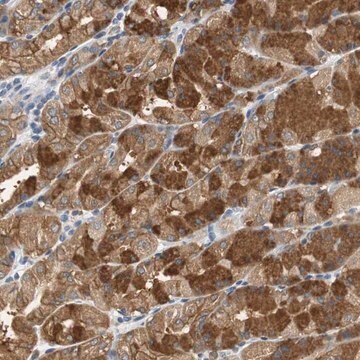ABE1942
Anti-TACC3 Antibody
from rabbit, purified by affinity chromatography
Synonym(s):
Transforming acidic coiled-coil-containing protein 3, ERIC-1
About This Item
Recommended Products
biological source
rabbit
Quality Level
antibody form
affinity isolated antibody
antibody product type
primary antibodies
clone
polyclonal
purified by
affinity chromatography
species reactivity
human
technique(s)
immunocytochemistry: suitable
western blot: suitable
UniProt accession no.
shipped in
ambient
target post-translational modification
unmodified
Gene Information
human ... TACC3(10460)
General description
Specificity
Immunogen
Application
Immunocytochemistry Analysis: A representative lot detected TACC3 spindle immunoreactivity in untransfected, but not TACC3 siRNA-transfected, SKOV-3 and OVCAR3 ovarian cancer cells (Rao, R., et al. (2014). Oncogene. 33(33):4242-4252).
Western Blotting Analysis: A representative lot detected much higher TACC3 expression in SKOV-3, OVCAR3 ovarian cancer cells than in non-cancerous hTERT-RPE, MCF10A, and 184B5 cells. Cellular TACC3 siRNA delivery abolished target band detection (Rao, R., et al. (2014). Oncogene. 33(33):4242-4252).
Epigenetics & Nuclear Function
Quality
Western Blotting Analysis: 1 µg/mL of this antibody detected TACC3 in 10 µg of HEK293 cell lysate.
Target description
Physical form
Storage and Stability
Handling Recommendations: Upon receipt and prior to removing the cap, centrifuge the vial and gently mix the solution. Aliquot into microcentrifuge tubes and store at -20°C. Avoid repeated freeze/thaw cycles, which may damage IgG and affect product performance.
Other Notes
Disclaimer
Not finding the right product?
Try our Product Selector Tool.
Storage Class Code
12 - Non Combustible Liquids
WGK
nwg
Certificates of Analysis (COA)
Search for Certificates of Analysis (COA) by entering the products Lot/Batch Number. Lot and Batch Numbers can be found on a product’s label following the words ‘Lot’ or ‘Batch’.
Already Own This Product?
Find documentation for the products that you have recently purchased in the Document Library.
Our team of scientists has experience in all areas of research including Life Science, Material Science, Chemical Synthesis, Chromatography, Analytical and many others.
Contact Technical Service